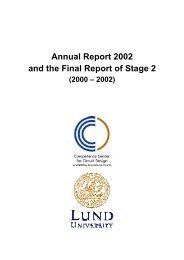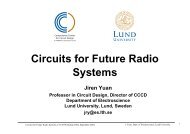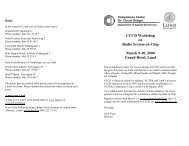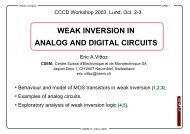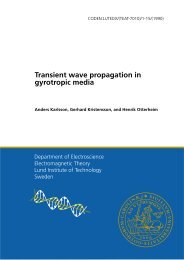Design of Antennas for Handheld DVB-H ... - Lunds tekniska högskola
Design of Antennas for Handheld DVB-H ... - Lunds tekniska högskola
Design of Antennas for Handheld DVB-H ... - Lunds tekniska högskola
You also want an ePaper? Increase the reach of your titles
YUMPU automatically turns print PDFs into web optimized ePapers that Google loves.
is simultaneously modulated into 1000 symbols <strong>of</strong> different carrier frequencies,<br />
then <strong>for</strong> each individual symbol there is a time slot available, which be<strong>for</strong>e<br />
changing to parallel transmission, was allotted to all the sequentially transmitted<br />
symbols together. The value <strong>of</strong> the bandwidth and the transmission time <strong>of</strong> some<br />
in<strong>for</strong>mation can vary as a function <strong>of</strong> each other. If OFDM is used to send a<br />
symbol the frequency range required <strong>for</strong> the transmission <strong>of</strong> an individual<br />
subsymbol is reduced [6].<br />
In the OFDM system all the subcarrier frequencies should be orthogonal to each<br />
other. To get the subcarriers to be orthogonal to each other the Inverse Discrete<br />
Fourier Trans<strong>for</strong>m (IDFT) must be calculated. It is necessary <strong>for</strong> a predetermined<br />
number <strong>of</strong> subsymbols to be available simultaneously at the input <strong>of</strong> the IDFT<br />
unit. The data that are to be transmitted are temporarily stored until the required<br />
number <strong>of</strong> subsymbols <strong>for</strong> parallel transmission are ready to be sent, and are then<br />
read out in parallel.<br />
One <strong>of</strong> the major problems <strong>of</strong> OFDM is that the peak amplitude <strong>of</strong> the emitted<br />
signal can be considerably higher than the average amplitude. This Peak to<br />
Average Ratio (PAR) problem comes from the fact that an OFDM signal is the<br />
superposition <strong>of</strong> all the sinusoidal signals <strong>of</strong> the different subcarriers. On average<br />
the emitted power is linearly proportional to the number <strong>of</strong> carriers. Sometimes<br />
the signals on the subcarriers ad up constructively and then the amplitude <strong>of</strong> the<br />
signal is proportional to the number <strong>of</strong> carriers. There are three ways <strong>of</strong> dealing<br />
with this:<br />
1. Use a power amplifier in the transmitter that can amplify linearly up to the<br />
possible peak value. This solution requires expensive and power<br />
consuming class A amplifiers.<br />
2. Use a nonlinear amplifier, and accept that the amplifier characteristic will<br />
lead to distortions <strong>of</strong> the output signal. Those nonlinear distortions destroy<br />
the orthogonality between the subcarriers, and also leads to out <strong>of</strong> band<br />
emissions.<br />
3. Use PAR reduction techniques. There are several different approaches<br />
these will not be described in this rapport.<br />
5



